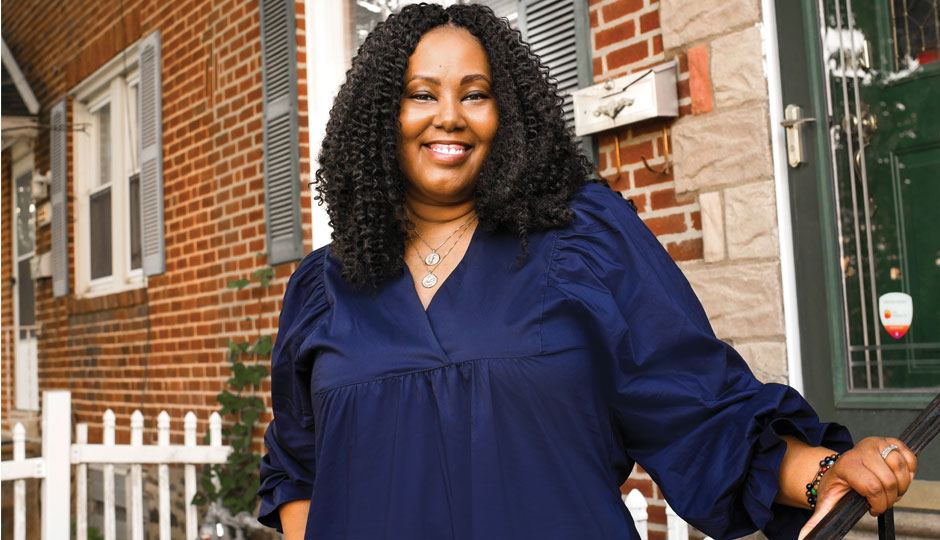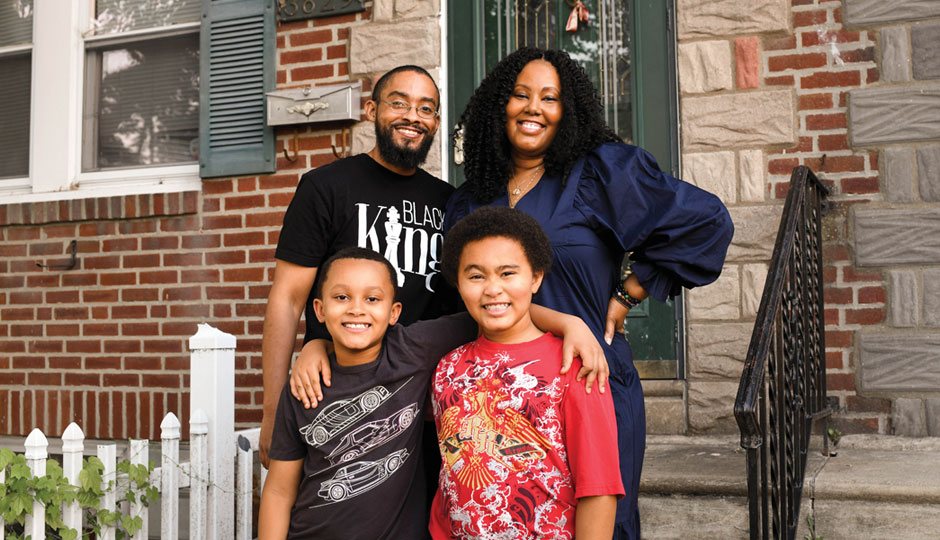Bridging the Gap: One Cancer Survivor’s Efforts to Affect Change on Outcome Disparities

No cancer diagnosis comes at a good time, but for Jamil Rivers, her metastatic breast cancer diagnosis was particularly poor timing. She had just started a new job as a finance executive and was eager to prove herself to her new employers. Her husband — a recent cancer survivor himself — and two of her sons, the youngest of whom was in kindergarten — were also on her work health insurance. She was also nervous because she had been let go from a job years before after becoming pregnant. She was certain what she did not want to do: walk into her new boss’ office and let him know that she was now undergoing treatment for an extreme case of metastatic breast cancer. Instead, she quickly began strategizing for how to keep her life functioning as normally as possible.
Rivers’ diagnosis was intimidating. Her breast cancer had already spread to nearly every organ in her body. Yet, she continued showing up to work each morning with a smile on her face, made small talk with co-workers about the weekend and excelled in her new role. Then, every Friday at the end of the work day, a volunteer or Lyft driver would pick her up through the American Cancer Society’s Road to Recovery program and take her to chemotherapy for the evening. A driver would again take her home that evening, and she’d switch into “mom mode” for the weekend.

“It became kind of a barometer for me,” she says. “If I could show up for work every day and keep on top of everything I had to do, and no one knew I had stage 4 breast cancer, then I must be doing ok.”
She started a checklist on her phone to track how she was feeling, and slowly added to it throughout her treatment. It grew into a cancer guide of sorts, including everything from diet and exercise to the types of body products she should be using, tips for supportive care like massage that helped her manage side effects, resources available to help and more.
“I went to the American Cancer Society’s website and basically applied for everything that was available after I plugged my zip code in,” she says. “Rides to treatment so my kids wouldn’t have to see me sick, childcare, a house cleaning. I even got connected with a grant to keep my kids in karate.”

During her Friday evenings in chemotherapy, other patients began gravitating around Rivers, noticing that she seemed to be doing and feeling OK despite having stage 4 breast cancer.
“That’s pretty much how I got involved with advocacy,” Rivers says. “It almost became like a breast cancer girlfriend club, where women were hearing about my little checklist, and learning from that and each other about how to manage side effects and everything.” The group kept growing, from five women to 10, 25, 50 — eventually, it became a large, thriving network.
In those conversations, Rivers realized many women were deeply overwhelmed by everything a cancer diagnosis entails. These women came from all different backgrounds, and some hadn’t had their treatment explained to them in a way they could understand, or didn’t realize they could get a second opinion regarding their treatment plan, or weren’t aware of the many resources available to them.
Her conversations also led her to begin researching how the disparities and discrimination that women experience can lead to vastly disparate outcomes.
“I learned that Black women are dying from breast cancer at a 40 percent higher rate than white women,” she says. “And it just didn’t make sense to me because we have so much innovation. I would always hear that it was just due to poverty, genetics, things like that. But seeing the research tied to disparities, it became clear that a big factor is also racism in the care setting.”
According to the American Cancer Society, 80 percent of what influences our health is not actually medically related, but driven by complex and interrelated social, economic, cultural, environmental and health system factors — called social determinants of health — that are historically linked to systemic discrimination or exclusion. Being able to pay for unexpected health bills or preventative health services, having access to healthy food, having a social support network that can help care for your kids and you during treatment, not having a care provider make assumptions about you based on your race, speaking the same language as your doctor — these factors can all have a significant influence on a person’s ability to prevent, find, treat and survive cancer.
There are also a number of populations in the U.S. who have a higher mistrust of the medical establishment, and for good reason — the healthcare system has a long history of harming Black Americans, from forced sterilizations of Black women to medical studies that tested on Black patients without their permission or knowledge. More recently, a 2012 study in the journal Pain Medicine found that Black patients are still consistently undertreated for pain relative to white patients. Tensions around immigration have also risen in recent years, and undocumented patients don’t always feel safe seeking care.
“When there’s a mistrust or fear of the healthcare system, there can be a tendency to only seek care when really, really sick,” says Natasha Coleman, the American Cancer Society’s senior director of Cancer Control Strategic Partnerships. “But regardless of where you live, or what background you come from, prevention and early detection benefits you.”
The Screening Solution
You can’t talk about the disparities in health outcomes without talking about cancer screenings. It’s common knowledge that the earlier you catch cancer, the easier it is to beat the disease. But not everyone has equal access to screenings, whether through living in a rural area, their work schedule, insurance status or language barriers.
Those are all issues that Coleman tries to help healthcare providers overcome. Her team works with healthcare providers to improve systems that identify patients who are in between care or often miss appointments, and make a concerted effort to reach patients who are due for a cancer screening. “We come in as kind of a coach to help health systems take a proactive approach,” she says. “We don’t want them to sit back and wait for patients to call and make their appointments.”
According to Coleman, many health systems are far from getting their patients back on track after delays from COVID-19.
“Screenings were seen as elective procedures, so they were lumped in with other procedures that were cancelled or postponed,” she says. “So there are delays in diagnosis with cancer that could have been detected in early 2020, and now likely have worse prospects.”
Increasing accessibility to screenings can be as simple as offering appointments after typical working hours or on the weekends. “Someone who does shift work can’t always just take time off during the day or step out for an hour for an appointment,” Coleman says.
Despite COVID-19 causing a setback, we’ve made huge progress in early screening for breast cancer, and the American Cancer Society is working to ensure that progress benefits everyone. They advocate for increased funding for the National Breast and Cervical Cancer Early Detection Program, which provides community-based breast screening and treatment services to low-income, uninsured and underinsured women. They also work to ensure that the Affordable Care Act keeps provisions that aid individuals of lower socioeconomic status, people of color, individuals with preexisting conditions and access to affordable prescriptions.
One crucial policy fight, according to Emma Watson, American Cancer Society Cancer Action Network’s government relations director for Pennsylvania, is ensuring that patients who receive medicaid have access to coverage without barriers, such as a work requirement. Some cancer patients are unable to work due to debilitating side effects of treatment, risk of infection or other health reasons, and work exemptions, even when available, can be complex and take time to process that many cancer patients don’t have.
“For low-income individuals with no other access to health coverage, having access to Medicaid could mean the difference between an early, treatable diagnosis and a later-stage diagnosis with far lower survival rates,” Watson says.
Culturally Sensitive Care
As a physician in North Philadelphia, Dr. Curtis Miyamoto, the associate director for clinical services at Fox Chase Cancer Center at Temple University Hospital, sees patients from an incredibly wide range of backgrounds and needs, from Russian translation to help finding a safe, clean place to live while undergoing treatment.
“All people deserve the same level of care, and so we want to make sure we’re the patient’s advocate, regardless of ethnicity, socioeconomic status, immigration status or anything else,” he says.
To Dr. Miyamoto, being an advocate extends far beyond just providing a course of treatment for his patients. He has patients come in with drug addiction, homelessness or other hurdles that have to be faced before the patient can even comprehend undergoing chemotherapy.
“What do you tell a mother who has three small kids at home, that she has to leave them alone every day and come in for treatment?” he says. “She’s stuck between doing something to help her for the long-term and abandoning her children for the short term. How can she do that? And so she decides her treatment based on her ability to get home and take care of her family.”
In some instances, he’s able to connect patients with one of his on-staff social workers or patient resources, such as the American Cancer Society’s Road to Recovery program that provided Rivers with rides to treatment. With some problems — such as not being able to prescribe pain medication to a patient because they’re addicted to heroin — there’s only so much he can do.
Dr. Miyamoto says overcoming language barriers, both in the hospital and in educational materials, is also crucial in Philadelphia, which has more than 145,000 residents who speak Spanish, 29,000 who speak Chinese and another 15,000 who speak Vietnamese, among many other languages. In North Philadelphia in particular, there’s a huge need for physicians who speak Russian.
“It’s one thing to go out and campaign in Chinatown to sign up for health coverage through the Affordable Care Act, but then after they sign up materials or a bill come in the mail in English and they’re like, ‘what is this?’ and throw it away,” he says.
He’s fluent in Spanish, and says that being able to speak directly with patients in their native language rather than through a translator makes a huge difference in terms of the patient understanding all aspects of the treatment and being comfortable asking questions about prevention, treatment and supportive care.
Making Her Mark
Three and a half years post-diagnosis, Rivers feels lucky: She’s beaten the odds and is currently cancer-free. Her “cancer girlfriends club” has turned into a rapidly growing nonprofit called The Chrysalis Initiative, which provides breast cancer coaching and support to patients with the aim of disrupting outcome disparities, particularly those caused through bias and racism in the healthcare setting. They also have initiatives aimed at educating healthcare providers about bias and racism and encouraging more young people of color to pursue medical careers in cancer care.
That list on her phone also turned into an app launching this month that guides women through the cancer process, providing the well-rounded insight, advice and community that so many of the women she met while in chemotherapy wished they had. Her resilience and drive continues to motivate many, and she’s since been featured in People magazine, on Good Morning America and elsewhere. Her biggest fan, however, remains her partner in life.
“She is basically like Wonder Woman,” says Rick Rivers, her husband of 10 years who is also a cancer survivor.
“She’s intelligent, determined, beautiful and brave. She’s taken on something that is so much bigger than herself, but she’s determined to succeed.”

